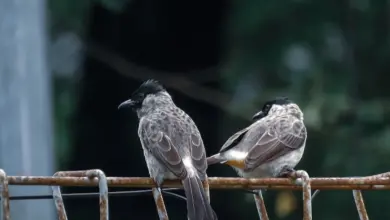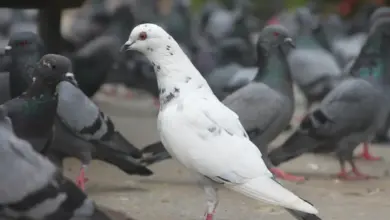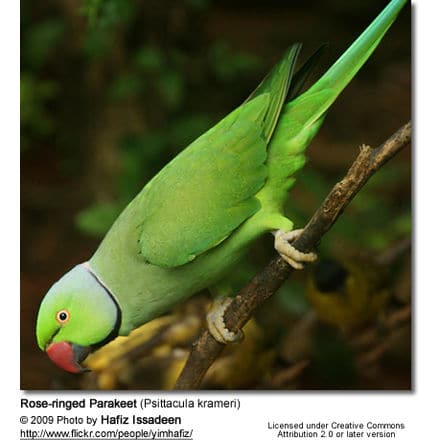Hummingbirds found in Montana, Northern USA
Hummingbirds found in the USA (by U.S. State) … Canada … Mexico … Puerto Rico … Jamaica … Honduras
Hummingbird Information
The following hummingbird species are known to occur in Montana.
Black-chinned Hummingbirds, Archilochus alexandri – Native Breeders
The males usually arrive at the end of April to mid-May. Females usually arrive a couple of weeks later. The males migrate back to their wintering grounds in mid- to late June, and are usually gone by the end of July. The females and young usually migrate south in July. Most will have left by the middle of August or early September. They are mostly found in steppe and Ponderosa pine zones (wetland areas, along rivers and in towns). Males often frequent drier areas than females.
The male has a black, shimmering throat with a purple edge and pale feathers below that create a collar. However, unless the light is just right, the head looks all black. His back is green and there are some green feathers covering the chest.
The female is pale below (sometimes with a slightly speckled throat) and her back is green.
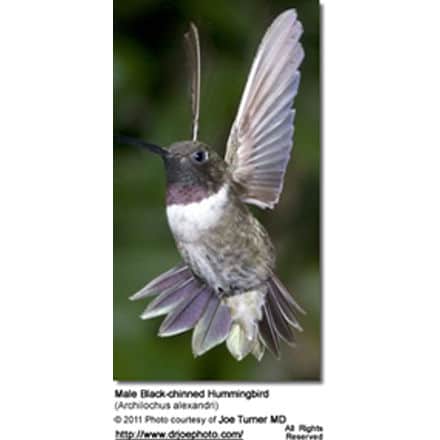
Rufous Hummingbirds, Selasphorus rufus – Native Breeders – Arrive in their breeding territory in mid-May (sometimes as early as end of April). They mostly nest in the mountains. From August / September, they migrate south to Mexico and Central America for the winter. Males usually depart first, and females and the young follow about two weeks later. They are usually all gone by early September.
These hummingbirds are often found in gardens and at hummingbird feeders. They are fearless, and are known for chasing other hummingbirds away from feeders and flowers.
Males can easily be identified by their glossy orange-red throats.
Females have whitish, speckled throats, green backs and crowns, and rufous, white-tipped tail feathers.
Calliope Hummingbirds, Stellula calliope – Native Breeders – Arrive in mid-May (sometimes as early as March for the breeding season and migrate south or east for the winter. They are usually gone by early September. They mostly nest in the mountains.
The smallest breeding bird in North America. They are most easily confused with the Rufous Hummingbirds and the Broad-tailed Hummingbird.

Anna’s Hummingbirds, Calypte anna– Native Breeders – They are usually found in suburban parks, gardens and valleys. Some Anna’s Hummingbirds are resident where food (flowers and feeders) and shelter is readily available. Anna’s may move seasonally to make best use of local resources, such as flowering seasons or availability of feeders – these movements are usually more to elevation than to latitude.
The largest hummingbird species in that region and one of the most vocal hummingbirds in the United States, where it is the only species to produce a song; specifically the males produce a complex series of scratchy noises, sounding like a sharp “chee-chee-chee; when moving from flower to flower, they emit toneless “chip” vocalizations. All other hummingbirds in the United States are mostly silent.
They are well known for their territorial behavior; the male makes elaborate dive displays at other birds and sometimes even at people. At the bottom of their dives, they produce high-pitched loud popping sounds with their tail feathers.
Males have glossy dark rose-red throats and crowns, which may appear black or dark purple in low light. The underside is mostly greyish; and the back metallic green.
Females have light grey chests with white and red spotting on the throat, greenish back and white tipped tails.
They resemble the Costa’s Hummingbirds, but the male’s Costa’s Hummingbird‘s gorget (throat feathers) is longer than that of the Anna’s. They are larger than the Rufous Hummingbirds and lack the rusty coloration of the Rufous Hummingbirds.

Broad-tailed Hummingbird, Selasphorus platycercus – Rare Vagrant – These migratory hummingbirds breed across mountain forests and meadows throughout the Western United States from eastern California and northern Wyoming south through Great Basin and Rocky Mountain states to southern Arizona and western Texas. They move south to winter in Mexico, Guatemala and, occasionally, El Salvador.
Males can most easily be identified by their iridescent, rose-red throats, white chest feathers and metallic green back and crown and their rounded tails. The males’ tails make whistling noises in flight.
Females lack the flashy throat patch of the male and are mostly pale below. Their white-tipped outer tail feathers are rust-colored close to the body and blackish in the center; the tail feathers in the center range from green to blackish.
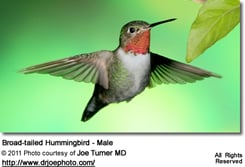
Costa’s Hummingbird, Calypte costae – Rare / Accidental
Males can easily be identified by the glossy purple crown and long, conspicuous throat feathers that project markedly down the side of the throats, giving it an elongated “moustache” appearance. The back is metallic green.
Females have greyish-green crowns (fop of the head) and backs. The chin and the plumage below are whitish, except for some black spotting on her throat. Her flanks are buffy-colored. She has a dark tail with white tips on the outer tail feathers.
They resemble the Anna’s Hummingbirds, but the male’s gorget (throat feathers) is longer than that of the Anna’s.
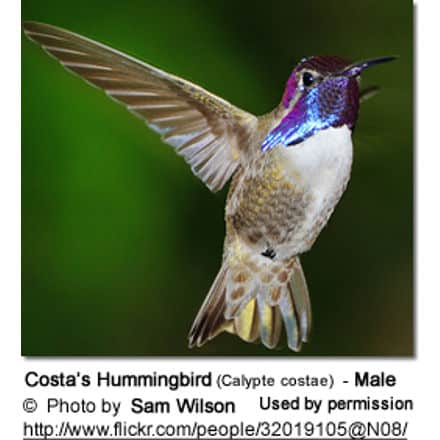
The favorite feeding plants for Montana Hummingbirds are:
Many hummingbirds favor red blossoms with a tubular shape (but some species prefer other colors). Hummingbirds feed readily on pink, blue, orange, peach and purple flowers.
In Montana, they are frequently seen feeding on the following native plants:
- wax currant (Ribes cereum)
- blue virgin’s bower (Clematis colombiana)
- serviceberry (Amelanchier alnifolia)
- golden currant (Ribes aureum)
- Oregon grape (Mahonia repens)
- hawthorn (Crataegus douglasii)
- Jacob’s ladder (Polemonium pulcherrimum)
- shrubby penstemon (Penstemon fruiticosa)


